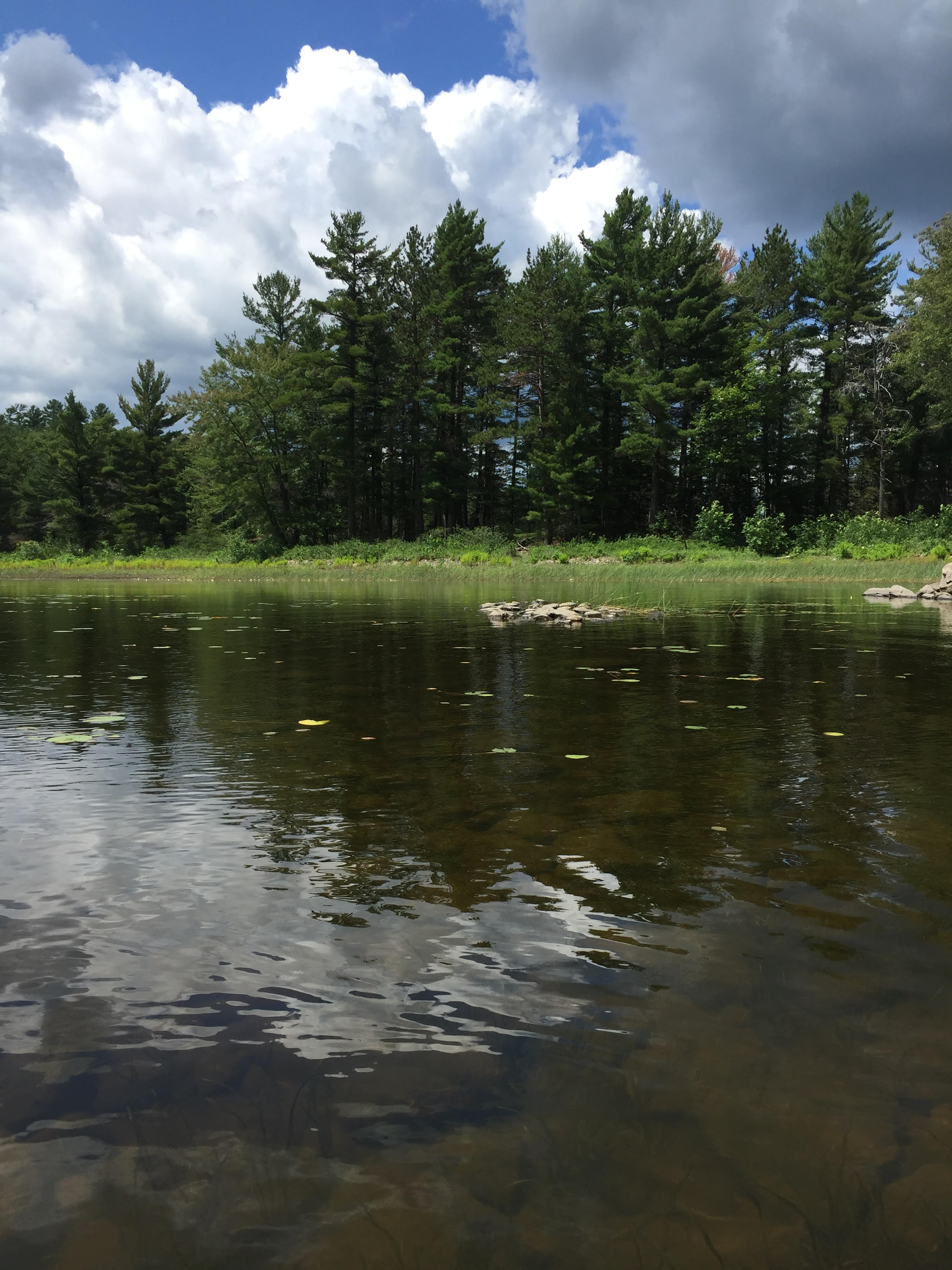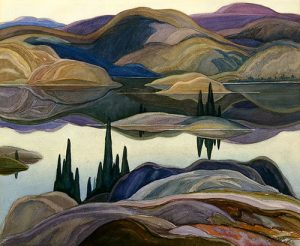
I’m writing this in the car travelling home from French River, a cottage locale situated as far north as Manitoulin Island and almost as far north as Sudbury. On our way up North, Dan and I stopped in Orillia, the birth town of The Group of Seven artist Frank Carmichael. Closer to our final destination, The Lodge at Pine Cove, we stopped at the French River Trading Post, and I picked up a copy of David P. Silcox’s lovely illustrated text The Group of Seven and Tom Thomson. Through its pages, I learned artist Tom Thomson died tragically by drowning before The Group of Seven was officially formed, but the group insisted he was very much a part of the movement and so he’s remained. This famous Group of Canadian artists defined Canada to the rest of the world through their sketches and paintings portraying Canada “the North” with images of nature, both dense and desolate; landscapes now synonymous with this country. I have at least one thing in common with Frank Carmichael, the Orillia native I mentioned earlier, which I will get to shortly.
On our four and a half hour drive from Peterborough – where we dropped the girls – on our way to French River, we skirted around Georgian Bay, past the Muskokas and along paved highway that cut through pink granite, the rocky face of Ontario’s North, bedrock better known as the Canadian Shield.
“Under the Canadian Shield is where they bury nuclear waste,” Dan informed me at some point during our 4.5 hour long conversation. “They dig deep, way down. It’s one of the safest places to put it.” I hated to think of this beautiful landscape as a dumping ground, but props to Dan for keeping the interesting facts coming on our lengthy drive.
On our way home, we stopped in Parry Sound for a quick Subway bite. My first trip to the area was at twelve years old for a gymnastics competition. I was in awe of the rock lining our passageway and the notion of workers having to blast through it to build the roads. Later, at a friend’s cottage, I slid off rocky slopes into smooth dark waters, and fully appreciated the region’s beauty. There is nothing quite like Northern Ontario.
While the magnitude and scope of the rock is impressive, what I’ve truly fallen in love with are the waterways. The bodies of fresh water.
From the beach of our cottage resort we launched our kayaks and let the river current pull us down stream along the shore line. Not far into our paddle, we came across a tiny inlet, the water level so low we could barely gain access. Our oblong boats glided across a narrow channel of rocks laying just below the surface, when around the bend, the pond came into view.
The pond was a wide, full circle dotted with lily pads and white flowers and lined by an audience of pines like spectators in an arena. As an island of rock blocked off the pond, separating it from the main flowing river, we found ourselves in a quiet, perfectly still sphere, save for the one startled fish who made a jump for it upon our arrival. Dan and I intuitively set down our paddles and floated together in silence, taking in the beauty around us. The pond was smooth as glass, and though I could spot the bottom if I tried, it was the surface reflecting the blue sky and onlooker trees like a mirror that caught my eye. With the sky above and the sky below me, was I in heaven? Yes.
This is where my sights and those of Frank Carmicheal aligned, our imaginations similarly captivated. Before I had a chance to properly read through The Group of Seven and Tom Thomson book I picked up, I titled this post Pools of Glass after the lasting impression of the pond lingering in my mind’s eye. Only later, in leafing through the pages, did I come across Carmichael’s famous painting, Mirror Lake, 1929 that exactly explores the quality of the water I so admired. Mirror Lake is a real place in the Muskokas, but the title of the painting was about more than a place. Carmichael and I each took notice of the northern water as glass reflecting the landscape like a mirror.

I don’t know if Carmichael felt the same way, but it wasn’t enough for me to look at the water, I needed to experience it.
In the mornings, I set out for my swims. I sliced through the deeper water off the dock, one, two, three, breathe right; one, two, three, breathe left. Swimming in fresh water is an act of meditation.
Dan kindly paced alongside me in his kayak, my protector from potential boats coming through. And snakes. I was weary of water snakes, though I shouldn’t have been.
Before we left on our trip, Dan’s sister lovingly sent us a picture of a three-foot long water snake her friend had just caught in French River. I asked the owner of the Lodge about water snakes upon our arrival, and he just shrugged with a laugh, “No, no. The snakes are my friends.” I wasn’t quite sure what he meant by that, but I took it as a sign not to be worried. I saw one cute baby snake scurry out of my path while hiking in the woods, but beyond that, nothing but plump loons and the occasional jumping fish in the water, in addition to a few toads and a muskrat while kayaking.
“The dogs on the property help to keep the black bears away,” the owner also informed Dan. Black bears. Who said anything about black bears?
During our stay in French River, our girls’ piano teacher happened to be visiting family in French River as well. She posted on Facebook about a close encounter with a water snake. I’m not crazy about the idea of encountering a snake in the water, but I can tell you last summer when we spent a week in the Bruce Peninsula region of Tobermory, with its crystal clear, frigid turquoise waters, the first thing I did at our cottage was swim across a small cove of water over to a large rock. I climbed up onto that rock, triumphant, saw a large snake, and immediately got back in the water and crossed the cove back to shore. As it turns out, that rock was the snake’s home and we later saw him zig-zagging through the water. Ariel and a friend were the first ones to spot him in the cove, while I was coming back in from a swim out into the depths of Lake Huron. The snake and I crossed paths, but he went the other way. That snake wanted nothing to do with me (the feeling was and is mutual). My point being: I’ve already experienced my first water snake, you’d think I’d be over it.
The first time Dan and I got in the water together at French River, he swam up behind me and playfully grabbed my toes (not funny). I reminded him that snakes usually swim on top of the water, they glide their bellies across it half immersed. Or so I thought. I later found this on the Ontario Nature site, “The northern watersnake eats fish and amphibians, hunting for its prey along the water’s edge or underwater. It is an excellent swimmer and can be found up to three metres below the surface of the water and several kilometres from shore.” Huh.
The idea of snakes gliding across the water’s surface grossed Dan out, as he had imagined the snakes resting at the bottom of the dark murky river, far down below in the fathoms we can’t see, which I think is infinitely worse. In general, I recommend not worrying about snakes when you’re swimming down a river. They’re certainly not worrying about you.
I wish I could pack a northern lake into my back pocket and take it home with me, snakes and all, but alas, I’m but a mere mortal, stranded and surrounded by dry ground. If I could swim in a lake every day, I would. Maybe one day I will.
I hope I come back as a water snake. I can see myself now, gliding serenely through pools of glass.





No comment yet, add your voice below!